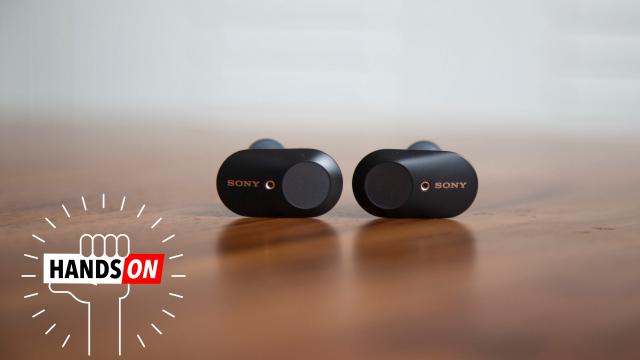Sony showed up early to the truly wireless noise-cancelling party in 2017, and now the company has an exciting new update: the WF-1000XM3 truly wireless earbuds.
They cost $399.95 and look like some silly mini version of the company’s popular WH-1000XM3 noise-cancelling headphones. That’s kind of the point, too. Apple’s AirPods have no noise-cancelling and the excellent Jabra Elite 65t only have noise reduction. Excellent noise-cancelling earbuds could be a big deal.
[referenced url=”https://gizmodo.com.au/2019/07/noise-wf-1000xm3-truly-wireless-noise-cancelling-headphones-australian-price-specs-release-date/” thumb=”https://gizmodo.com.au/wp-content/uploads/2019/07/sony-wireless-buds-1-410×231.jpg” title=”Sony Unveils Sexy Wireless Noise Cancelling Earbuds” excerpt=”Today Sony unveiled its latest in wireless headphone range – WF-1000XM3. In addition to being cordless, these earbuds boast noise cancellation that the company is calling ‘the next level of silence’.”]
The new earbuds feature a new version of the same chip that makes their over-ear counterpart so powerful. Sony calls it the HD Noise Cancelling Processor QN1e chip, and to help it out, the WF-1000XM3 earbuds have two more microphones than their predecessors did.
There are now two in each earbud, which not only helps noise-cancelling but also improves audio quality for phone calls and whatnot.
That QN1e is evidently the real star of the show, though. Sony says that it’s able to achieve a new level of noise-cancelling by taking the audio that comes in from the dual-mic system and then feeding it through the QN1e chip to cancel out ambient sound.
This is how all noise-cancelling headphones work, but according to Sony, having a dedicated chip do the work does it better. The company says that the QN1e chip also helps improve sound quality.
But how much magic can a chip really make? Well, it’s worth considering the new truly wireless earbuds’ big sibling, the WH-1000XM3 noise-cancelling headphones, which were the first Sony headphones to feature the HD Noise Cancelling Processor QN1.
While it’s worth wondering if the jargon-laden technology amounts a marketing gimmick, the WH-1000XM3 headphones did cancel noise better than their predecessors, the WH-1000XM2, which were already better than the popular Bose QuietComfort 35ii headphones.
So by putting a version of that chip in its new truly wireless earbuds, Sony is banking on spin a little bit. Then again, in early testing, the WF-1000XM3 also cancel noise better than their predecessors, the WF-1000X.
Enough of that alphabet soup. I’ve spent a week with a preproduction set of the Sony’s new truly wireless earbuds, and I have to admit that they’re pretty slick, and they seem to do a respectable job with noise-cancelling.
They’re also undeniably nice-looking with a clean design that sits right outside your ear and has a touch-sensitive control on the outside of each bud. The bud itself juts out of the back side of the body, so the whole situation sort of balances in your ear canal. So far, they’ve felt pretty secure.
What I actually think is remarkable about the new Sony earbuds is how well they work just as regular wireless earbuds. Like AirPods, the new Sony buds have proximity sensors, so that they turn on as soon as they go into your ears and off when they come out.
I never worried about keeping them powered on and connected to my phone, although Sony does say that the earbuds can only connect to one device at a time. Sony also makes no claims about the earbuds being waterproof, so that’s something to consider.
Sony told me that it worked hard to improve connectivity all around on the WF-1000XM3. Unlike the model from a couple years ago, these buds feature Bluetooth 5, and each one maintains an independent connection with your device.
This is supposed to cut down on what I’d call the ping-pong effect that some earbuds suffer from. That’s the one where sound bounces from earbud to the other or just drops off of one side. My experience with the new approach is so far positive, but again, I’ve only had them a week.
I plan on spending more time with the WF-1000XM3 and writing a full review. I’ll be looking to see how well the noise-cancelling works in a variety of situations and also to see if Sony’s promise of improved battery life really holds up.
The WF-1000XM3 earbuds are supposed to get six hours of battery life with noise-cancelling and eight hours without. For $399.95, which is around $70 more than the Jabra Elite 65t, my current favourite truly wireless earbuds, the new Sony buds better keep all their promises.
The WF-1000XM3 earbuds will be available in Australia from July.
